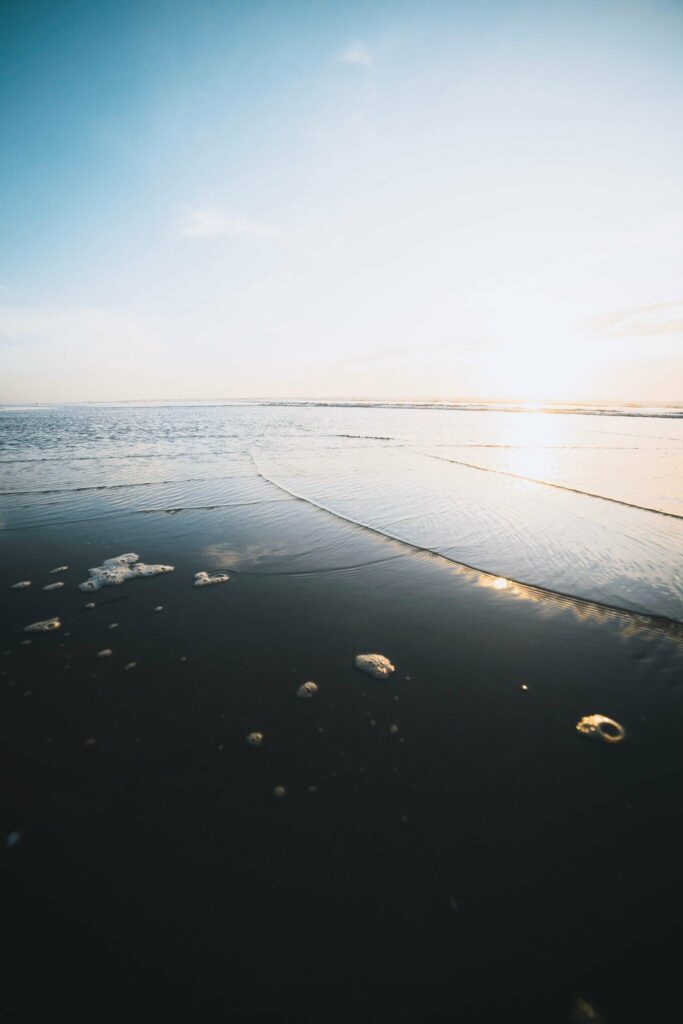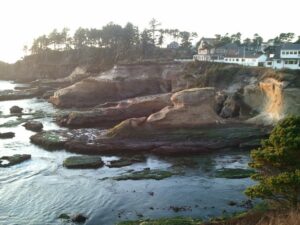
By: Karissa Courtney
CONTENTS
THE OCEAN- BACKGROUND
Intro
We (The OPI Team) love the ocean, and so do most other people! It is mesmerizing, expansive, and so beautiful. Whenever I spend time with the ocean, I feel so overwhelmed with feelings, like I’m witnessing something so much greater than myself and humanity. With the ocean comes the salty breeze, whipping through your hair, possibly chilling you, but bringing the smell of the sea to your nose. It gives life to the tide pools, bringing the much needed salty brine to our beloved sea stars, anemones, hermit crabs, and so many other tiny creatures. The ocean moves the sand up and down, the sand that gets between our toes, the sand that somehow gets into every tiny crevice of your body, but brings joy. The sand that we walk upon, that we run on, that we lay and lounge on, and that we enjoy ourselves on. It’s no wonder then, that people love to write about it, like Emily Dickinson in By The Sea:
And made as he would eat me up
As wholly as a dew
Upon a dandelion’s sleeve –
And then I started too.
And he – he followed close behind;
I felt his silver heel
Upon my ankle, – then my shoes
Would overflow with pearl.
Until we met the solid town,
No man he seemed to know;
And bowing with a mighty look
At me, the sea withdrew.
I started early, took my dog,
And visited the sea;
The mermaids in the basement
Came out to look at me.
And frigates in the upper floor
Extended hempen hands,
Presuming me to be a mouse
Aground, upon the sands.
But no man moved me till the tide
Went past my simple shoe,
And past my apron and my belt,
And past my bodice too,
It’s also no wonder that we love to spend time in and by the sea, and that sometimes means vacationing! Our homes are all oceanfront — we feel the pull of the ocean and the beauty that it brings, and of course we love to share this with others. The ocean is precious and I have provided some more information on the ocean and its health.
Thanks for reading!

Is there more than one?
The earth actually just has one large ocean and all of the “oceans” that you know (Pacific, Atlantic, Indian, Arctic, Southern) are connected basins. The ocean covers over 70% of the earth and because of the currents, trash and other pollutants can travel all around the globe. The surface currents are influenced by the wind and the earth’s rotation, while the deeper currents are caused by a difference in temperature/density.
THE OCEAN IS
HOME TO
BOTH
MICROSCOPIC
ORGANISMS,
AS WELL AS
THE LARGEST
ANIMAL
ON EARTH—THE
BLUE WHALE
Tides
You have probably heard a lot about tides- they affect beach time, when you can fish, when you can best see the tide pools, where you can swim (rip tides!), etc. You also have probably heard that they are caused by the moon, but the sun also plays a part in creating these. The moon’s gravitational force on the earth, pushes and pulls on the water, while the sun’s gravitational force can add to the lunar tides when it lines up with the moon in orbit.
The ocean shapes the earth
Many of the geologic changes occur where the ocean meets the land (ever heard of the ring of fire?). The tectonic plate movement in these areas can cause volcanoes and coastal mountains to form (we have these!), earthquakes, and tsunamis. Weathering and erosion from the ocean wind and waves also drastically change the landscape. The coastline can be changed in the short term – uneven sand levels, as well as the long term – receding shoreline, which is a huge issue for many cities on the coast!
OCEAN
ECOSYSTEMS
HAVE THE
GREATEST
ABUNDANCE OF
LIFE AND
THE GREATEST
DIVERSITY ON THE
PLANET.
The ocean can also shape the weather and climate – making it habitable
Surprisingly, the ocean actually is an important player in heating the planet. The majority of the sun’s radiation is absorbed by the ocean and is retained – mostly around the equator where it’s warmer. The land absorbs heat as well, but water does a much better job due its high specific heat capacity (the highest of any liquid on earth). Specific heat capacity is the amount of heat a substance can absorb to change its temperature —in the case of water, lots of heat can be absorbed before the water actually gets warmer. This makes the fact that the ocean is getting drastically warmer, an even larger problem/shock.
Additionally, the ocean helps distribute this heat around the globe. When water molecules are heated, they expand, but they also evaporate. Ocean water is constantly evaporating from being heated on the surface by the sun, which then increases the temperature and humidity of the surrounding air, forming rain and storms which are often carried large distances from the wind. Much of the rain that falls on land starts off in the ocean. Weather patterns are also largely driven by the ocean currents and act like a transportation system, moving warm water from the equator to the poles and the cold water from the poles back to the tropics. This is why the East Coast of the United States has really warm water (currents are coming up from the equator and distributing warm water here), while the West Coast of the U.S. has really cold water, which you have probably experienced (currents from the Arctic are coming down and distributing their cold water here)!
ALL OF EARTH’S OXYGEN
IN THE ATMOSPHERE
CAME FROM
PHOTOSYNTHETIC
ORGANISMS IN THE
OCEAN. AND TODAY,
STILL MOST OF THE
EARTH’S OXYGEN IS
PRODUCED BY MARINE
PLANTS.
Therefore, ocean currents help regulate global climate. Without them, regional temperatures would be much more extreme—super hot at the equator and extremely cold at the poles—and much of earth’s land would be inhabitable. You can see then, how long-term changes in ocean temperature could have a large affect on the climate.
Humans and the ocean are very connected
The ocean fuels economies, feeds communities, and supports societies—but humans also influence the ocean, often in negative ways. Around the world, fish from the ocean provides 6.7% of all protein consumed. Overfishing is already an issue, and it can have large consequences to food webs that is reducing our ability to harvest more fish. Oceans also help us produce energy (e.g.wave power, tidal power, ocean thermal energy)and are used for shipping goods. Offshore drilling is also a huge source of the gas and oil for the planet (more than 1/3), but oil spills happen all of the time. We often only hear about the larger spills, but thousands of small spills occur in U.S. waters every year, which severely damages sea life. Shipping can also be an issue for the ocean—cargo containers are spilled, waste water is dumped, and pollution from the ships is released into the ocean. Not to mention, that whales, dolphin, and other larger mammals can be killed by these large boats moving too quickly.
People also love to live by the ocean (hence our vacation homes!), and about 40% of the world’s population lives within 60 miles of the coast, and is continually growing. All of these people can have a large impact on the ocean— we change the landscape and shoreline, our waste and our animals’ waste often run-off into the ocean, and oil from our cars run off as well.
BELOW ARE BIG ISSUES HAPPENING TODAY WITH OCEAN HEALTH, AND SOME WAYS YOU CAN HELP!
OCEAN ACIDIFICATION
You’ve probably heard the term “Ocean Acidification”, but what does it mean? First off, it has everything to do with carbon dioxide (CO2). Since the Industrial Revolution, the amount (concentration) of carbon dioxide in the atmosphere has been increasing. This is due to the burning of fossil fuels—such as driving cars, burning coal, cooking with gas— as well as from the change in land use—deforestation for farming, draining wetlands for building, and permafrost melting. Around 30% of the carbon dioxide that is released into the atmosphere, is absorbed by the ocean.
When this happens, the amount of CO2 in the ocean increases, leading to ocean acidification. When CO2 is absorbed in the ocean, there are an increase of hydrogen ions, which causes the water to have a lower pH, or become more acidic. With more acidic waters, come more problems for marine life. Calcifying organisms, such as oysters, corals, clams, and others that have shells, have a very hard time with increased acidity. The ocean water actually starts to dissolve/ corrode the animals’ skeletons (corals) and shells. Other fish are also affected though. Some fish have a decreased ability to detect predators in more acidic waters, and if these fish are disappearing faster than they normally should, the entire food web can fall apart.

PHARMACEUTICALS & BIOACCUMULATION
Many of us take prescription medications to treat a variety of ailments. After our bodies process these, the leftover drugs are excreted through our urine. From our bodies to the toilet, this medicated urine then passes through treatment plants where they are filtered and then deposited back into our water system. However, these treatment plants to not treat the urine to remove pharmaceuticals, and so these pass back into our water. Additionally, many people flush drugs and pills down the toilet, and these coupled with our medicated urine, make their way back into the ocean.
When these drugs make it into the ocean, they bioaccumulate in fish, which means they build up in these organisms and cannot be fully excreted. Most of these drugs are antibiotics, antidepressants, hormones, and painkillers, and they can change how the fish live. Hormones change reproduction, antibiotics lead to antibiotic resistance, sunscreen coats corals and kills them, and many more. Additionally, if we eat these fish, then we are potentially exposed to medicated fish meats.

WILDLIFE INTERACTIONS
Remember when you’re on the beach that you should not be touching marine animals! United States law protects marine animals and prohibits the disturbance and harassment of them, especially marine mammals (e.g.whales, dolphins, sea otters, sea lions).
- Stay at least 100 yards away from all marine mammals
- Be aware of other animals in the surrounding area
- Respect the habitat by speaking quietly and taking your trash with you
- Do not touch, feed, or lure animals
- Never get between an animal and a way for them to leave
- If an animal appears nervous, move further away
If you are visiting tide pools, be aware when you are walking on rocks, that there are often small animals that live there. A lot of the time they may even seem to be rocks themselves, such as barnacles, which hurt your feet to walk on. You can touch tide pool animals, but you may not hold them, especially out of the water.




FISHING
Where did your fish come from? How was it fished?
Much of the fish people eat comes from over-fishing. This occurs when more fish are caught than the population can replace, and has been going on throughout the world for decades. Today, there are half as many fish in the ocean as there were in 1970, and some species such as tuna and mackerel have declined by as much as 75%.
Overfishing is a large culprit in disrupting food webs—when populations of fish disappear or decline, entire ecosystems are affected. If the large, top predator fish are gone, then the smaller fish are left without anyone keeping their population in check, which leads to more herbivorous fish being eaten, thus resulting in more sea weeds and sea grasses, which can be bad for coral reefs (just one example). Overfishing doesn’t only hurt the fish though, fishers could eventually lose their business if they catch most of the large fish at once because these fish cannot reproduce quickly enough and therefore cannot continue being fished.
Many fishing practices are not sustainable. Bottom-trawling is one of the worst ways to fish. This is where fishermen simply drag a gigantic net along the bottom of the seabed and bring whatever they catch, up to the surface (sometimes this is very far and fish will die from the rapid change in pressure). When fishing this way, you cannot stop the accidental catching of other fish that you do not want- this is called by-catch —and when this happens, these unwanted (and usually dead) fish are just tossed back into the water. This is a huge waste of sea life, and can be catastrophic for ecosystems. Other unsustainable ways of fishing include: longline fishing, cyanide fishing, dynamite fishing, and ghost fishing.
Farming is an alternative way to get the fish that consumers so desperately want, and it’s not all bad, like some believe. Aquaculture is used to raise more animals for food, but also used to rebuild crashing wild populations. When done sustainably, aquaculture feeds farmed fished in an environmentally friendly way, avoids harming wild populations, and minimizes pollution. However, much the seafood in the U.S. is important and half of this import is from foreign aquaculture where it’s unregulated. So, before buying fish or ordering it at a restaurant, ask where the fish came from and how it was harvested.
We have a list of great local fish markets and restaurants HERE.





MARINE DEBRIS
I’m sure that you’ve heard of the giant trash island in the middle of the ocean. Well this starts with trash on the street, that then gets swept down storm drains and out into the ocean. Only 20% of marine debris comes from fishing and shipping, and the other 80% comes from litter on land and the beach. Worldwide, most of the marine debris is plastic, which cannot ever be composted or rid of. It may get broken down, but this turns into micro-plastics that we are now seeing in the stomachs of fish and large marine mammals, and in our drinking water! Synthetic fibers from manmade fabrics are also making their way into the ocean from washing machines. More than 800 species worldwide are affected by micro-plastics and can damage the digestive tracts, poison them, lead them to starvation, and alter their regular behaviors.
SEA LEVEL RISE
The sea level is different depending where you are on the planet and there some things that can make it uneven: gravity, tides, shoreline formations, and ocean currents.
However, rising global temperature is also altering the sea level. Melting glaciers and ice caps are flowing into the ocean, causing it to rise. But additionally, when water warms, the molecules expands, so much of the sea level rise is due to the expansion of the water molecules (known as thermal expansion). Sea level rise is a huge problem because about 40% of the U.S. population lives in coastal areas that will be flooded from a rising sea (including some of our homes!). Higher than normal tides can also send storm waters farther inland and damage tunnels, buildings, roads, bridges, and sewage plants. Seawater (it’s salty) could also leak into freshwater drinking reservoirs and ruin agricultural land. Climate models predict a sea level rise between 1 and 6 feet by 2100 depending on where you are.
Sea Level Rise Viewer
WHAT YOU CAN DO
- Switch to clean energy—e.g. solar, wind, hydro
- Drive your car less. Take public transportation or ride your bike more.
- Eat a plant-based diet —much of the greenhouse gases come from livestock and producing meat for consumption.
- Trade in disposable products (e.g. paper napkins, plastic straws, plastic cups and utensils) for reusable ones, avoid any personal care products with micro-beads, properly dispose of fishing materials, and pick up litter!
- Don’t flush your medications. Find out where you can properly dispose of your old medicines.
- Prevent marine debris and clean up local streams, rivers, estuaries, and/or beaches.
- Try to produce less waste and recycle and compost more!
- Assist local estuaries, parks, or other natural areas with planting or restoring native vegetation.
- Plant trees and gardens—grow your own vegetables! Or buy from local small farms or markets.
- Monitor and save water resources – e.g. turn the water off when you brush your teeth, take shorter showers, put in a low-flow shower head and toilet




WANT TO LEARN MORE? CHECK OUT THE NATIONAL OCEANIC AND ATMOSPHERIC ADMINISTRATION (NOAA)
*All facts and statistics from The National Oceanic and Atmospheric Administration


